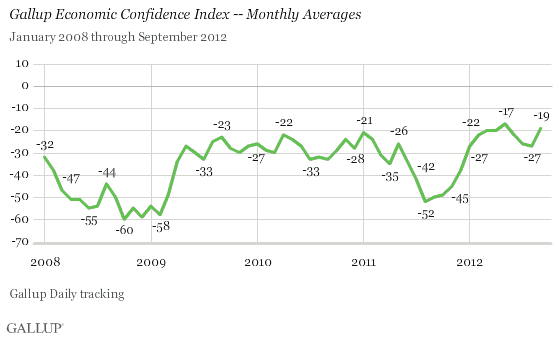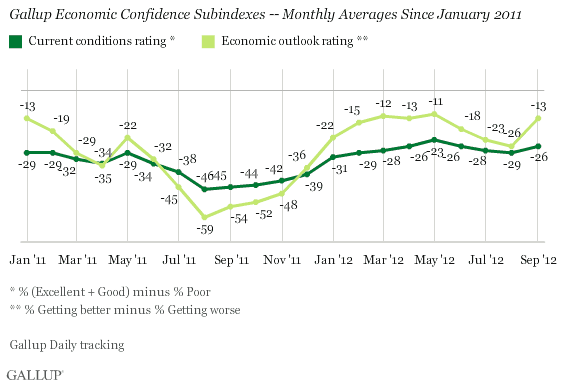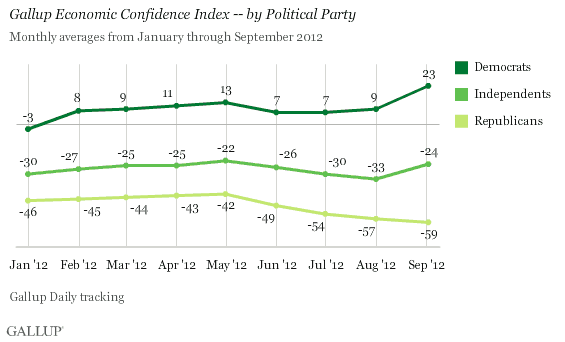PRINCETON, NJ -- The Gallup Economic Confidence Index averaged -19 in September, up from -27 in August and nearly matching the -17 seen in May, the highest monthly reading since the start of Gallup Daily tracking in 2008.

The monthly reading is based on interviews with more than 14,000 national adults in Gallup Daily tracking from Sept. 1-30, and thus represents a true average of consumer attitudes over the entire month.
The eight-percentage-point overall improvement in September is almost entirely owing to a jump in Americans' economic outlook, rather than their evaluation of current economic conditions. Of the two index components, the outlook rating rose 13 points in September, to -13, while the current conditions rating rose three points, to -26.

Democrats Drive Improvements in September
As Gallup reported in weekly updates of economic confidence in September -- on Sept. 11, Sept. 18, and Sept. 25 -- confidence has surged among Democrats, but has also improved somewhat among independents. For the month, Democrats' confidence was up 14 points, to +23, and independents' was up nine points, to -24. At the same time, Republicans' confidence was down slightly, at -59.

In line with the overall results, the improvement in Democrats' and independents' economic confidence occurred mainly in their outlook for the economy, rather than in their ratings of current conditions.

Improved Confidence Evident Each Week of September
Americans' economic confidence moved sharply higher starting on Sept. 4, the first night of the Democratic National Convention, so that for the week ending Sept. 9 it was up 11 points to -18. It remained at that level for the next two weeks, through Sept. 23. And while it dipped slightly to -21 in the week ending Sept. 30, it remained well above the -26 to -29 range seen in August's weekly averages.

Bottom Line
Democrats and, to a lesser degree, independents became significantly more optimistic about the economy's direction in September, pushing the overall Gallup Economic Confidence Index up eight points to -19, nearly the highest it's been in more than four years. While the catalyst for this optimism appears to have been the Democratic National Convention at the start of September, the effect persisted, with only a slight easing in the fourth week, ending Sept. 30.
Overall, it is clear that politics is playing an inordinately large role in economic perceptions. As such, it will be important to take that into account when examining consumer attitudes through the final month of the U.S. presidential campaign and at the start of the next administration, particularly if there is a change in power.
Gallup.com reports results from these indexes in daily, weekly, and monthly averages and in Gallup.com stories. Complete trend data are always available to view and export in the following charts:
Daily: Employment, Economic Confidence, Job Creation, Consumer Spending
Weekly: Employment, Economic Confidence, Job Creation, Consumer Spending
Read more about Gallup's economic measures.
View our economic release schedule.
Survey Methods
Results are based on telephone interviews conducted as part of Gallup Daily tracking Sept. 1-30, 2012, with a random sample of 14,390 adults, aged 18 and older, living in all 50 U.S. states and the District of Columbia.
For results based on the total sample of national adults, one can say with 95% confidence that the maximum margin of sampling error is ±1 percentage point.
Interviews are conducted with respondents on landline telephones and cellular phones, with interviews conducted in Spanish for respondents who are primarily Spanish-speaking. Each sample includes a minimum quota of 400 cell phone respondents and 600 landline respondents per 1,000 national adults, with additional minimum quotas among landline respondents by region. Landline telephone numbers are chosen at random among listed telephone numbers. Cell phone numbers are selected using random-digit-dial methods. Landline respondents are chosen at random within each household on the basis of which member had the most recent birthday.
Samples are weighted by gender, age, race, Hispanic ethnicity, education, region, adults in the household, and phone status (cell phone only/landline only/both, cell phone mostly, and having an unlisted landline number). Demographic weighting targets are based on the March 2011 Current Population Survey figures for the aged 18 and older non-institutionalized population living in U.S. telephone households. All reported margins of sampling error include the computed design effects for weighting and sample design.
The questions reported here were asked of a random half-sample of respondents each night on the Gallup Daily tracking survey.
In addition to sampling error, question wording and practical difficulties in conducting surveys can introduce error or bias into the findings of public opinion polls.
For more details on Gallup's polling methodology, visit www.gallup.com.
